Report on Hofstede's Cultural Dimensions: Study Skills Evaluation
VerifiedAdded on 2021/01/02
|6
|1387
|409
Report
AI Summary
This report evaluates Hofstede's cultural dimensions, focusing on masculinity vs. femininity and collectivism vs. individualism. It analyzes the dimensions and presents arguments for the benefits of collectivism and femininity within organizations and societies. The report suggests the use of long and short-term orientation and uncertainty avoidance dimensions to improve organizational culture. It references several academic sources to support its claims and concludes by emphasizing the advantages of collectivism and femininity, as well as the importance of utilizing specific cultural dimensions for organizational and societal development. The report explores how these dimensions influence leadership and organizational values, providing a comprehensive overview of cultural impacts.

STUDY SKILL
Paraphrase This Document
Need a fresh take? Get an instant paraphrase of this document with our AI Paraphraser
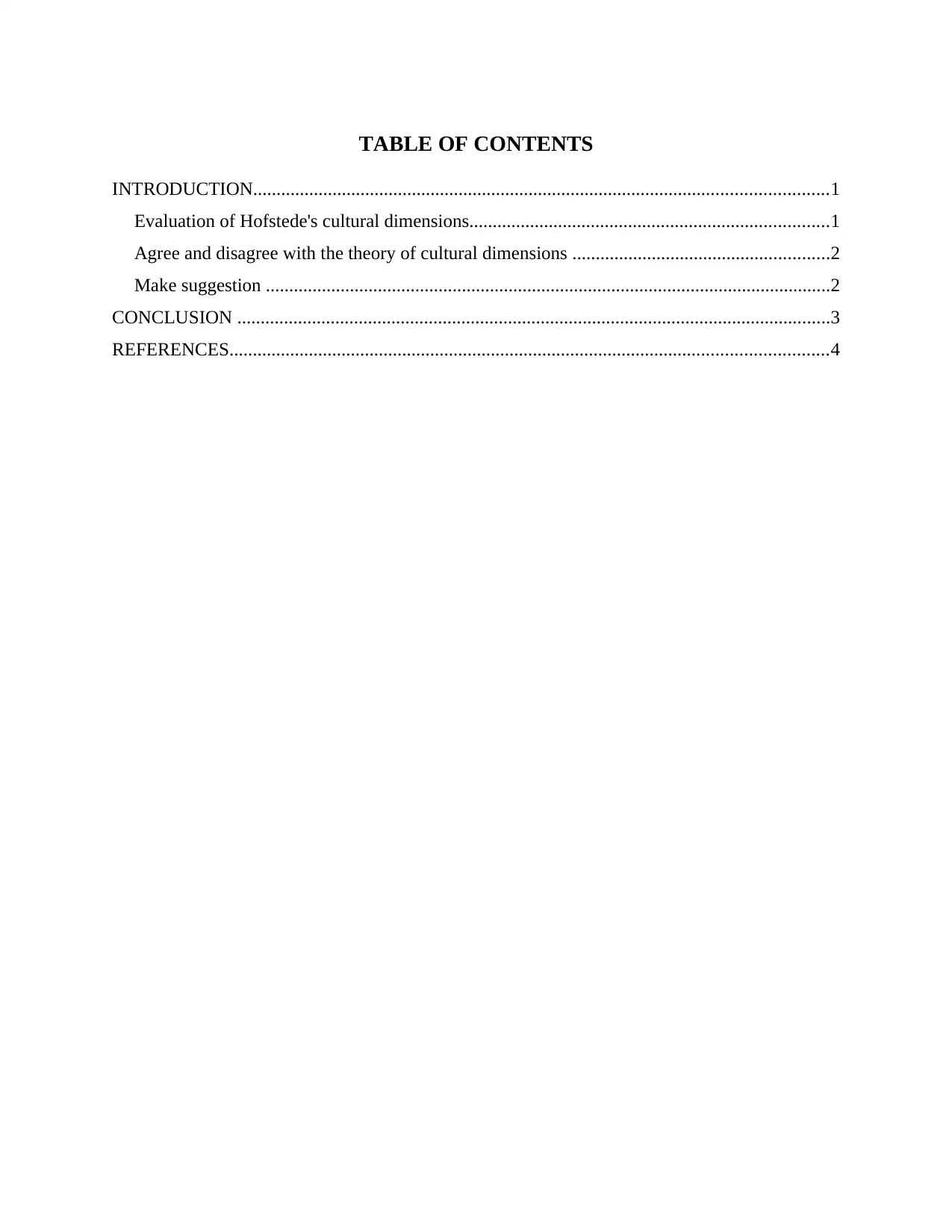
TABLE OF CONTENTS
INTRODUCTION...........................................................................................................................1
Evaluation of Hofstede's cultural dimensions.............................................................................1
Agree and disagree with the theory of cultural dimensions .......................................................2
Make suggestion .........................................................................................................................2
CONCLUSION ...............................................................................................................................3
REFERENCES................................................................................................................................4
INTRODUCTION...........................................................................................................................1
Evaluation of Hofstede's cultural dimensions.............................................................................1
Agree and disagree with the theory of cultural dimensions .......................................................2
Make suggestion .........................................................................................................................2
CONCLUSION ...............................................................................................................................3
REFERENCES................................................................................................................................4
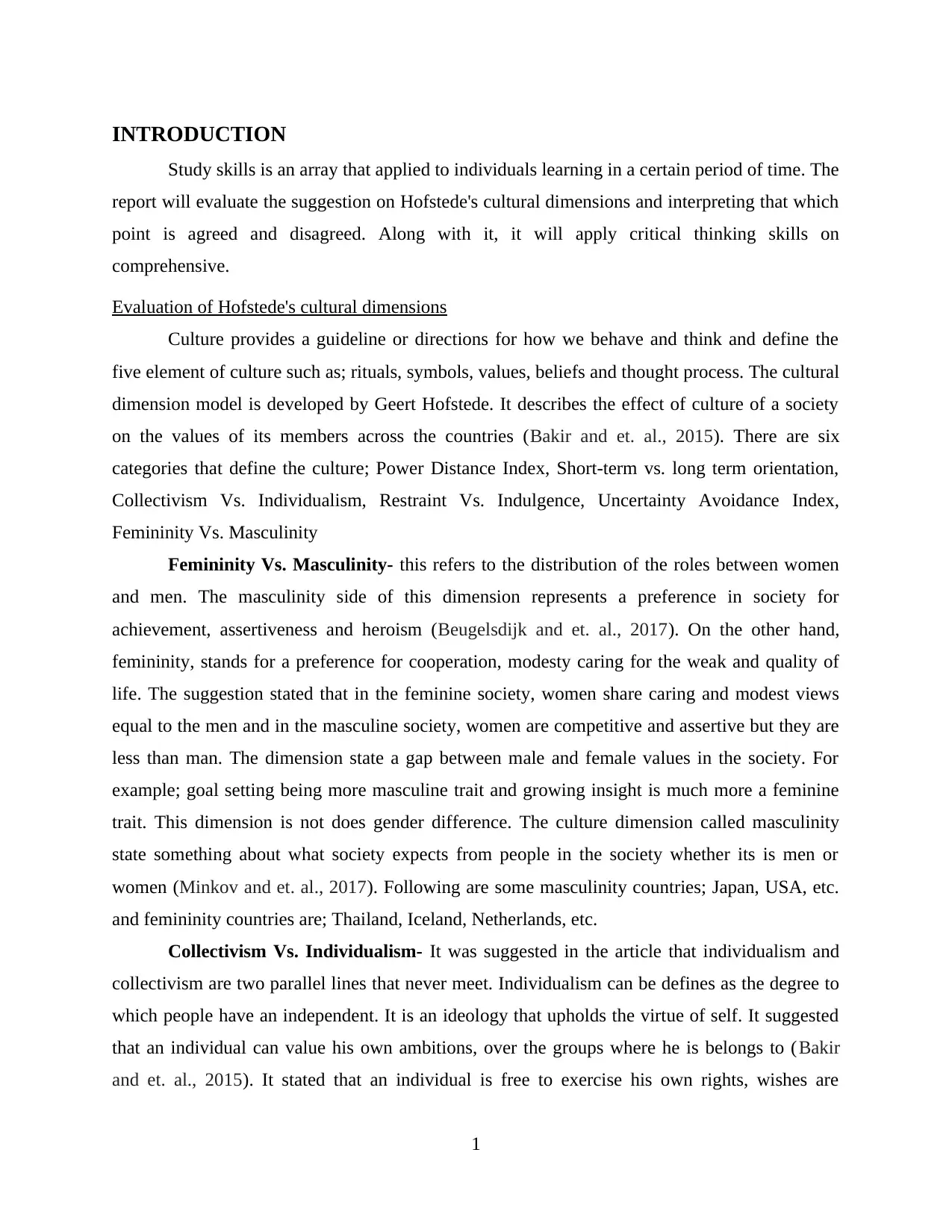
INTRODUCTION
Study skills is an array that applied to individuals learning in a certain period of time. The
report will evaluate the suggestion on Hofstede's cultural dimensions and interpreting that which
point is agreed and disagreed. Along with it, it will apply critical thinking skills on
comprehensive.
Evaluation of Hofstede's cultural dimensions
Culture provides a guideline or directions for how we behave and think and define the
five element of culture such as; rituals, symbols, values, beliefs and thought process. The cultural
dimension model is developed by Geert Hofstede. It describes the effect of culture of a society
on the values of its members across the countries (Bakir and et. al., 2015). There are six
categories that define the culture; Power Distance Index, Short-term vs. long term orientation,
Collectivism Vs. Individualism, Restraint Vs. Indulgence, Uncertainty Avoidance Index,
Femininity Vs. Masculinity
Femininity Vs. Masculinity- this refers to the distribution of the roles between women
and men. The masculinity side of this dimension represents a preference in society for
achievement, assertiveness and heroism (Beugelsdijk and et. al., 2017). On the other hand,
femininity, stands for a preference for cooperation, modesty caring for the weak and quality of
life. The suggestion stated that in the feminine society, women share caring and modest views
equal to the men and in the masculine society, women are competitive and assertive but they are
less than man. The dimension state a gap between male and female values in the society. For
example; goal setting being more masculine trait and growing insight is much more a feminine
trait. This dimension is not does gender difference. The culture dimension called masculinity
state something about what society expects from people in the society whether its is men or
women (Minkov and et. al., 2017). Following are some masculinity countries; Japan, USA, etc.
and femininity countries are; Thailand, Iceland, Netherlands, etc.
Collectivism Vs. Individualism- It was suggested in the article that individualism and
collectivism are two parallel lines that never meet. Individualism can be defines as the degree to
which people have an independent. It is an ideology that upholds the virtue of self. It suggested
that an individual can value his own ambitions, over the groups where he is belongs to (Bakir
and et. al., 2015). It stated that an individual is free to exercise his own rights, wishes are
1
Study skills is an array that applied to individuals learning in a certain period of time. The
report will evaluate the suggestion on Hofstede's cultural dimensions and interpreting that which
point is agreed and disagreed. Along with it, it will apply critical thinking skills on
comprehensive.
Evaluation of Hofstede's cultural dimensions
Culture provides a guideline or directions for how we behave and think and define the
five element of culture such as; rituals, symbols, values, beliefs and thought process. The cultural
dimension model is developed by Geert Hofstede. It describes the effect of culture of a society
on the values of its members across the countries (Bakir and et. al., 2015). There are six
categories that define the culture; Power Distance Index, Short-term vs. long term orientation,
Collectivism Vs. Individualism, Restraint Vs. Indulgence, Uncertainty Avoidance Index,
Femininity Vs. Masculinity
Femininity Vs. Masculinity- this refers to the distribution of the roles between women
and men. The masculinity side of this dimension represents a preference in society for
achievement, assertiveness and heroism (Beugelsdijk and et. al., 2017). On the other hand,
femininity, stands for a preference for cooperation, modesty caring for the weak and quality of
life. The suggestion stated that in the feminine society, women share caring and modest views
equal to the men and in the masculine society, women are competitive and assertive but they are
less than man. The dimension state a gap between male and female values in the society. For
example; goal setting being more masculine trait and growing insight is much more a feminine
trait. This dimension is not does gender difference. The culture dimension called masculinity
state something about what society expects from people in the society whether its is men or
women (Minkov and et. al., 2017). Following are some masculinity countries; Japan, USA, etc.
and femininity countries are; Thailand, Iceland, Netherlands, etc.
Collectivism Vs. Individualism- It was suggested in the article that individualism and
collectivism are two parallel lines that never meet. Individualism can be defines as the degree to
which people have an independent. It is an ideology that upholds the virtue of self. It suggested
that an individual can value his own ambitions, over the groups where he is belongs to (Bakir
and et. al., 2015). It stated that an individual is free to exercise his own rights, wishes are
1
⊘ This is a preview!⊘
Do you want full access?
Subscribe today to unlock all pages.

Trusted by 1+ million students worldwide
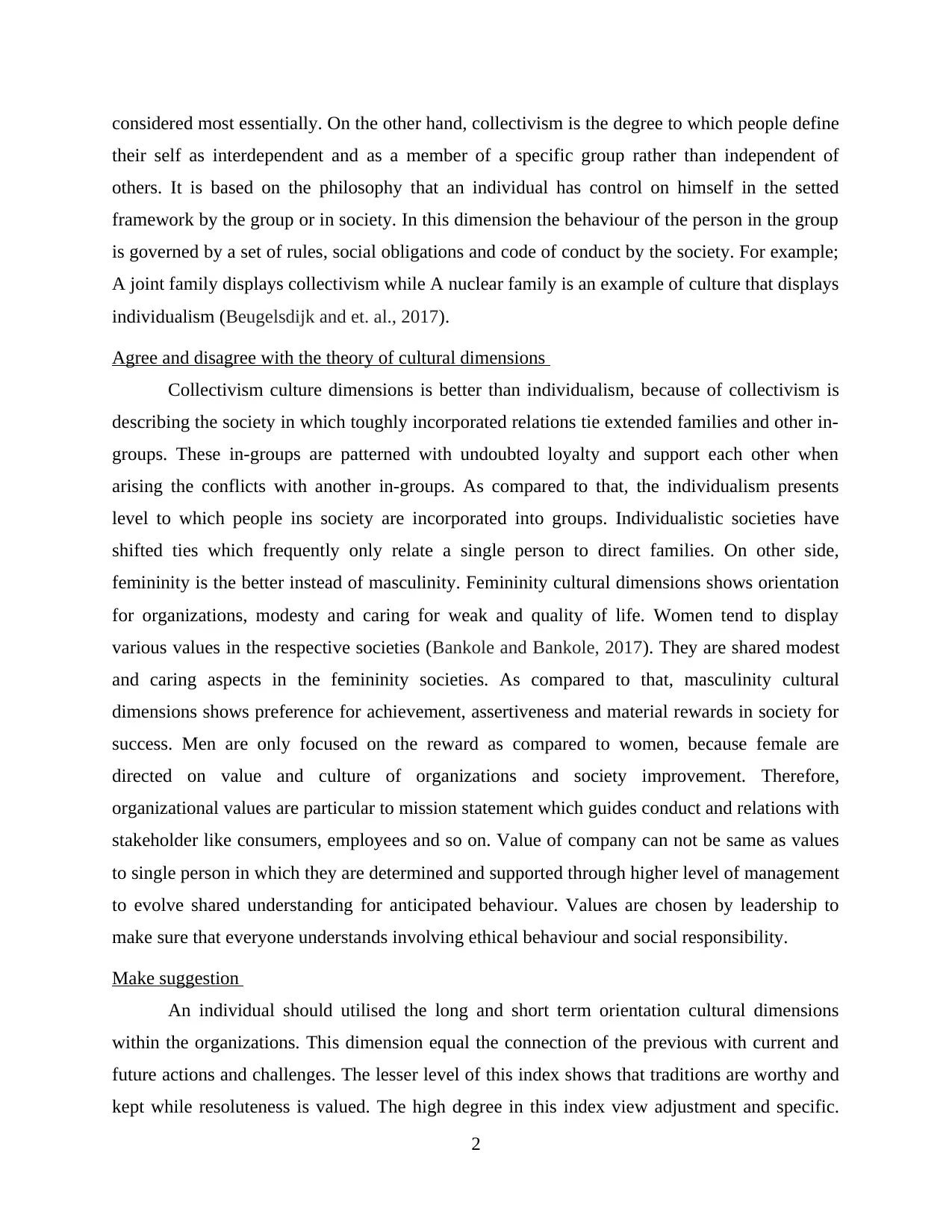
considered most essentially. On the other hand, collectivism is the degree to which people define
their self as interdependent and as a member of a specific group rather than independent of
others. It is based on the philosophy that an individual has control on himself in the setted
framework by the group or in society. In this dimension the behaviour of the person in the group
is governed by a set of rules, social obligations and code of conduct by the society. For example;
A joint family displays collectivism while A nuclear family is an example of culture that displays
individualism (Beugelsdijk and et. al., 2017).
Agree and disagree with the theory of cultural dimensions
Collectivism culture dimensions is better than individualism, because of collectivism is
describing the society in which toughly incorporated relations tie extended families and other in-
groups. These in-groups are patterned with undoubted loyalty and support each other when
arising the conflicts with another in-groups. As compared to that, the individualism presents
level to which people ins society are incorporated into groups. Individualistic societies have
shifted ties which frequently only relate a single person to direct families. On other side,
femininity is the better instead of masculinity. Femininity cultural dimensions shows orientation
for organizations, modesty and caring for weak and quality of life. Women tend to display
various values in the respective societies (Bankole and Bankole, 2017). They are shared modest
and caring aspects in the femininity societies. As compared to that, masculinity cultural
dimensions shows preference for achievement, assertiveness and material rewards in society for
success. Men are only focused on the reward as compared to women, because female are
directed on value and culture of organizations and society improvement. Therefore,
organizational values are particular to mission statement which guides conduct and relations with
stakeholder like consumers, employees and so on. Value of company can not be same as values
to single person in which they are determined and supported through higher level of management
to evolve shared understanding for anticipated behaviour. Values are chosen by leadership to
make sure that everyone understands involving ethical behaviour and social responsibility.
Make suggestion
An individual should utilised the long and short term orientation cultural dimensions
within the organizations. This dimension equal the connection of the previous with current and
future actions and challenges. The lesser level of this index shows that traditions are worthy and
kept while resoluteness is valued. The high degree in this index view adjustment and specific.
2
their self as interdependent and as a member of a specific group rather than independent of
others. It is based on the philosophy that an individual has control on himself in the setted
framework by the group or in society. In this dimension the behaviour of the person in the group
is governed by a set of rules, social obligations and code of conduct by the society. For example;
A joint family displays collectivism while A nuclear family is an example of culture that displays
individualism (Beugelsdijk and et. al., 2017).
Agree and disagree with the theory of cultural dimensions
Collectivism culture dimensions is better than individualism, because of collectivism is
describing the society in which toughly incorporated relations tie extended families and other in-
groups. These in-groups are patterned with undoubted loyalty and support each other when
arising the conflicts with another in-groups. As compared to that, the individualism presents
level to which people ins society are incorporated into groups. Individualistic societies have
shifted ties which frequently only relate a single person to direct families. On other side,
femininity is the better instead of masculinity. Femininity cultural dimensions shows orientation
for organizations, modesty and caring for weak and quality of life. Women tend to display
various values in the respective societies (Bankole and Bankole, 2017). They are shared modest
and caring aspects in the femininity societies. As compared to that, masculinity cultural
dimensions shows preference for achievement, assertiveness and material rewards in society for
success. Men are only focused on the reward as compared to women, because female are
directed on value and culture of organizations and society improvement. Therefore,
organizational values are particular to mission statement which guides conduct and relations with
stakeholder like consumers, employees and so on. Value of company can not be same as values
to single person in which they are determined and supported through higher level of management
to evolve shared understanding for anticipated behaviour. Values are chosen by leadership to
make sure that everyone understands involving ethical behaviour and social responsibility.
Make suggestion
An individual should utilised the long and short term orientation cultural dimensions
within the organizations. This dimension equal the connection of the previous with current and
future actions and challenges. The lesser level of this index shows that traditions are worthy and
kept while resoluteness is valued. The high degree in this index view adjustment and specific.
2
Paraphrase This Document
Need a fresh take? Get an instant paraphrase of this document with our AI Paraphraser
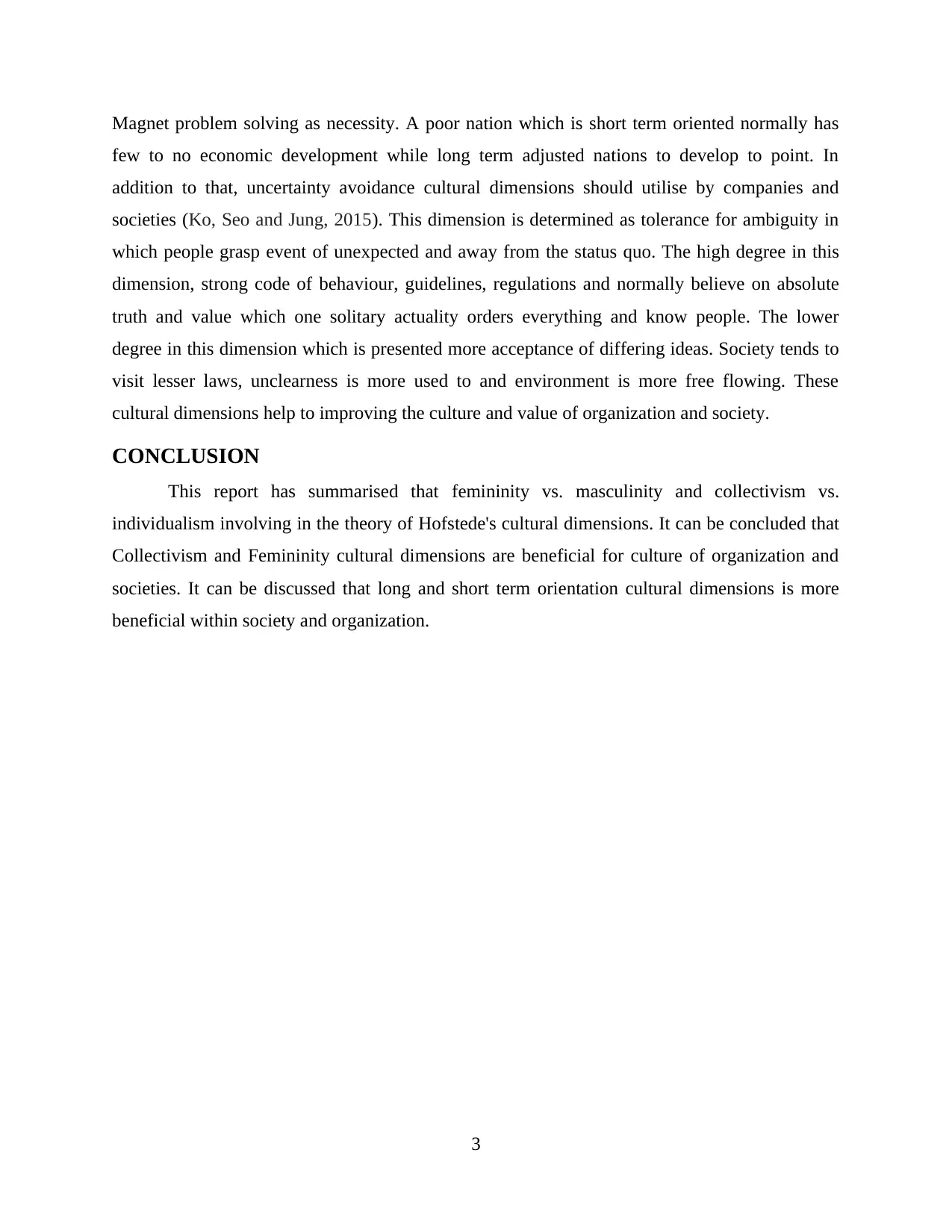
Magnet problem solving as necessity. A poor nation which is short term oriented normally has
few to no economic development while long term adjusted nations to develop to point. In
addition to that, uncertainty avoidance cultural dimensions should utilise by companies and
societies (Ko, Seo and Jung, 2015). This dimension is determined as tolerance for ambiguity in
which people grasp event of unexpected and away from the status quo. The high degree in this
dimension, strong code of behaviour, guidelines, regulations and normally believe on absolute
truth and value which one solitary actuality orders everything and know people. The lower
degree in this dimension which is presented more acceptance of differing ideas. Society tends to
visit lesser laws, unclearness is more used to and environment is more free flowing. These
cultural dimensions help to improving the culture and value of organization and society.
CONCLUSION
This report has summarised that femininity vs. masculinity and collectivism vs.
individualism involving in the theory of Hofstede's cultural dimensions. It can be concluded that
Collectivism and Femininity cultural dimensions are beneficial for culture of organization and
societies. It can be discussed that long and short term orientation cultural dimensions is more
beneficial within society and organization.
3
few to no economic development while long term adjusted nations to develop to point. In
addition to that, uncertainty avoidance cultural dimensions should utilise by companies and
societies (Ko, Seo and Jung, 2015). This dimension is determined as tolerance for ambiguity in
which people grasp event of unexpected and away from the status quo. The high degree in this
dimension, strong code of behaviour, guidelines, regulations and normally believe on absolute
truth and value which one solitary actuality orders everything and know people. The lower
degree in this dimension which is presented more acceptance of differing ideas. Society tends to
visit lesser laws, unclearness is more used to and environment is more free flowing. These
cultural dimensions help to improving the culture and value of organization and society.
CONCLUSION
This report has summarised that femininity vs. masculinity and collectivism vs.
individualism involving in the theory of Hofstede's cultural dimensions. It can be concluded that
Collectivism and Femininity cultural dimensions are beneficial for culture of organization and
societies. It can be discussed that long and short term orientation cultural dimensions is more
beneficial within society and organization.
3
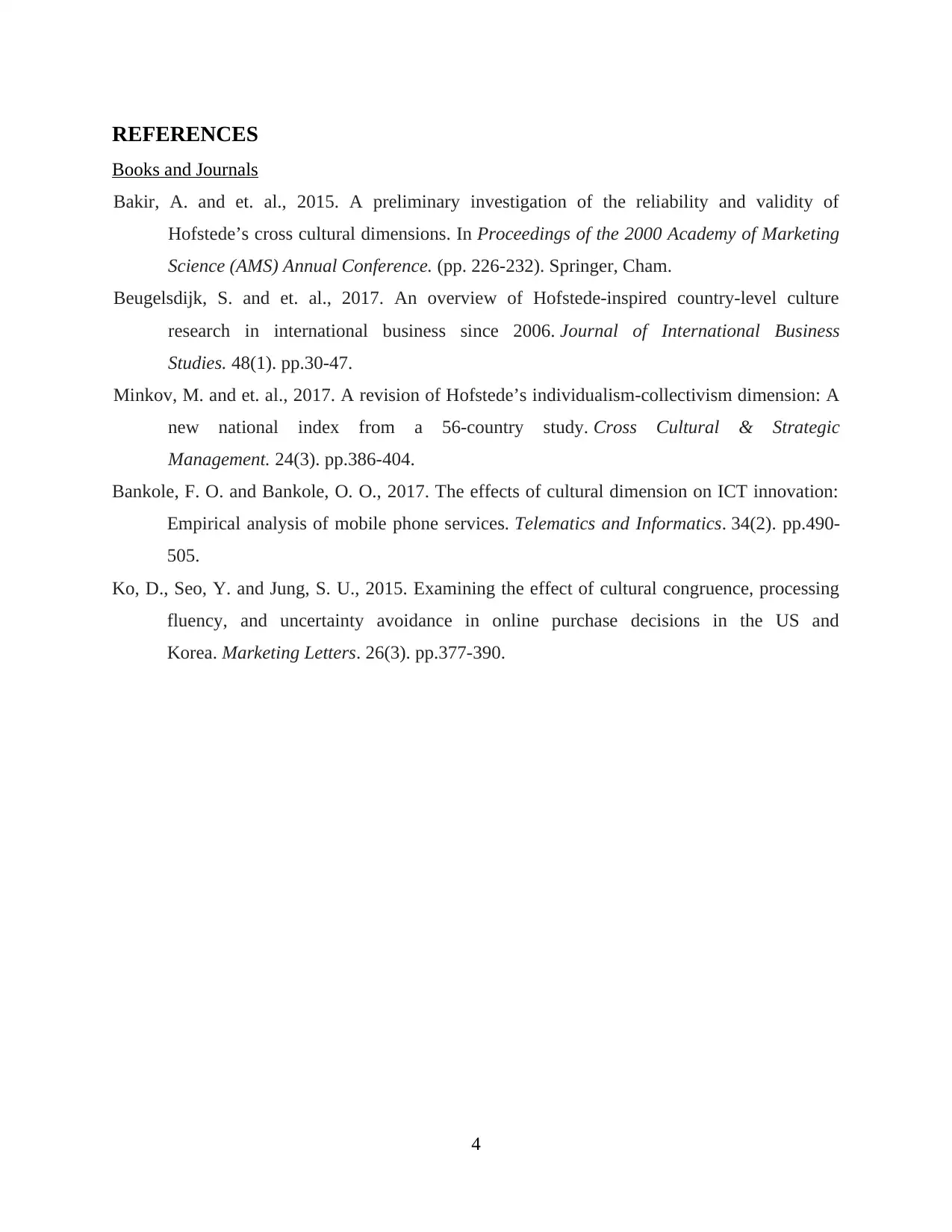
REFERENCES
Books and Journals
Bakir, A. and et. al., 2015. A preliminary investigation of the reliability and validity of
Hofstede’s cross cultural dimensions. In Proceedings of the 2000 Academy of Marketing
Science (AMS) Annual Conference. (pp. 226-232). Springer, Cham.
Beugelsdijk, S. and et. al., 2017. An overview of Hofstede-inspired country-level culture
research in international business since 2006. Journal of International Business
Studies. 48(1). pp.30-47.
Minkov, M. and et. al., 2017. A revision of Hofstede’s individualism-collectivism dimension: A
new national index from a 56-country study. Cross Cultural & Strategic
Management. 24(3). pp.386-404.
Bankole, F. O. and Bankole, O. O., 2017. The effects of cultural dimension on ICT innovation:
Empirical analysis of mobile phone services. Telematics and Informatics. 34(2). pp.490-
505.
Ko, D., Seo, Y. and Jung, S. U., 2015. Examining the effect of cultural congruence, processing
fluency, and uncertainty avoidance in online purchase decisions in the US and
Korea. Marketing Letters. 26(3). pp.377-390.
4
Books and Journals
Bakir, A. and et. al., 2015. A preliminary investigation of the reliability and validity of
Hofstede’s cross cultural dimensions. In Proceedings of the 2000 Academy of Marketing
Science (AMS) Annual Conference. (pp. 226-232). Springer, Cham.
Beugelsdijk, S. and et. al., 2017. An overview of Hofstede-inspired country-level culture
research in international business since 2006. Journal of International Business
Studies. 48(1). pp.30-47.
Minkov, M. and et. al., 2017. A revision of Hofstede’s individualism-collectivism dimension: A
new national index from a 56-country study. Cross Cultural & Strategic
Management. 24(3). pp.386-404.
Bankole, F. O. and Bankole, O. O., 2017. The effects of cultural dimension on ICT innovation:
Empirical analysis of mobile phone services. Telematics and Informatics. 34(2). pp.490-
505.
Ko, D., Seo, Y. and Jung, S. U., 2015. Examining the effect of cultural congruence, processing
fluency, and uncertainty avoidance in online purchase decisions in the US and
Korea. Marketing Letters. 26(3). pp.377-390.
4
⊘ This is a preview!⊘
Do you want full access?
Subscribe today to unlock all pages.

Trusted by 1+ million students worldwide
1 out of 6
Related Documents
Your All-in-One AI-Powered Toolkit for Academic Success.
+13062052269
info@desklib.com
Available 24*7 on WhatsApp / Email
![[object Object]](/_next/static/media/star-bottom.7253800d.svg)
Unlock your academic potential
Copyright © 2020–2025 A2Z Services. All Rights Reserved. Developed and managed by ZUCOL.





